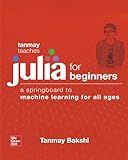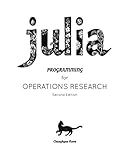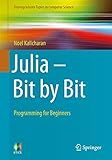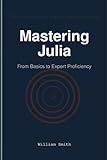Best Julia Programming Books to Buy in January 2026

Think Julia: How to Think Like a Computer Scientist



Tanmay Teaches Julia for Beginners: A Springboard to Machine Learning for All Ages



Julia Programming for Operations Research



Ultimate Parallel and Distributed Computing with Julia For Data Science: Excel in Data Analysis, Statistical Modeling and Machine Learning by ... Programming — Parallel Systems Path)



Julia - Bit by Bit: Programming for Beginners (Undergraduate Topics in Computer Science)



Algorithms with JULIA: Optimization, Machine Learning, and Differential Equations Using the JULIA Language



Practical Julia: A Hands-On Introduction for Scientific Minds



Julia Programming Projects: Learn Julia 1.x by building apps for data analysis, visualization, machine learning, and the web



Mastering Julia: From Basics to Expert Proficiency



Advanced Julia Programming: Comprehensive Techniques and Best Practices


In Julia, the symbol => is used to create pairs in key-value associations, particularly in dictionaries. It is also referred to as the "pair constructor." The purpose of => is to assign a value to a corresponding key, allowing for efficient and convenient lookup and retrieval of values.
The syntax for using => is as follows:
key => value
Here, key represents the identifier that will be used to access the associated value, and value represents the actual data or object being assigned to the key. This notation lets you specify relationships between keys and their corresponding values in a concise manner.
For example, consider the following dictionary:
dict = Dict("apple" => 1, "banana" => 2, "orange" => 3)
This dictionary associates the keys "apple", "banana", and "orange" with their respective values 1, 2, and 3. Accessing the values can be done using the keys:
println(dict["apple"]) # Output: 1 println(dict["banana"]) # Output: 2 println(dict["orange"]) # Output: 3
The use of => in Julia enables easy creation and manipulation of dictionaries, promoting efficient data organization and retrieval. It simplifies the process of accessing values based on their associated keys, making code more readable and facilitating faster execution.
How to iterate over key-value pairs using => in Julia?
In Julia, you can iterate over key-value pairs of a dictionary using => in a for loop. Here's an example:
dict = Dict("apple" => 1, "banana" => 2, "orange" => 3)
for (key, value) in dict println("Key: $key, Value: $value") end
Output:
Key: "banana", Value: 2 Key: "apple", Value: 1 Key: "orange", Value: 3
In the above example, dict is a dictionary with keys as strings and values as integers. The for loop iterates over each key-value pair in dict, where key represents the key and value represents the corresponding value. You can then perform operations on key and value within the loop.
What does => do when used with comprehension syntax in Julia?
In Julia, the => symbol is used as a mapping operator when used with comprehension syntax. It is used to specify a key-value pair in a comprehension, where the key is on the left side of the operator, and the value is on the right side.
For example, when creating a dictionary comprehension, the => operator is used to specify the key-value pairs:
dict = Dict(i => i^2 for i in 1:5)
This code will create a dictionary where the keys are the numbers 1 to 5, and the values are the squares of those numbers.
Similarly, the => operator can be used in other types of comprehensions, such as array comprehensions, where it specifies the value to be included in the resulting array:
squares = [i^2 for i in 1:5 => mod(i, 2) == 0]
This code will create an array of squares, but only for the numbers in the range 1 to 5 that are even.
What does => signify in the context of tuples and named tuples in Julia?
In Julia, the => symbol is a shorthand notation utilized for creating key-value pairs within tuples and named tuples.
A tuple is an immutable, ordered collection of elements, and you can create a key-value pair tuple by using the => operator to separate the key and its associated value. For example:
julia_tuple = ("key" => "value")
This will create a tuple julia_tuple with a single key-value pair: ("key" => "value").
Named tuples, on the other hand, are similar to regular tuples but possess named fields that allow accessing values via dot notation. The => operator is used in named tuples to assign names to elements. Here's an example:
julia_namedtuple = (key = "value")
This will create a named tuple julia_namedtuple with a single field key and its associated value: (key = "value").
In short, => is a shorthand syntax for defining key-value pairs in tuples and named tuples in Julia.
What is the purpose of the => symbol in Julia?
The => symbol in Julia is used to define a pair (association) within a dictionary or a NamedTuple. It is called the "pair operator". The syntax key => value is used to associate a key with a value within a dictionary or NamedTuple.
For example, we can create a dictionary using =>:
dict = Dict("key1" => 10, "key2" => 20, "key3" => 30)
Here, "key1", "key2", "key3" are keys, and 10, 20, 30 are their associated values.
Similarly, we can create a NamedTuple using =>:
nt = (a = 1, b = 2, c = 3)
In this case, a, b, c are field names, and 1, 2, 3 are their associated values.
How to assign a value to a specific key using => in Julia?
In Julia, you can assign a value to a specific key using the => syntax within a dictionary. Here's an example:
# Create an empty dictionary dict = Dict()
Assign a value to a key using =>
dict["key"] = "value"
Print the updated dictionary
println(dict) # Output: Dict("key" => "value")
You can also assign multiple key-value pairs using => within a single statement. Here's an example:
# Create an empty dictionary dict = Dict()
Assign multiple key-value pairs using =>
dict["key1"] = 1 => "value1" dict["key2"] = 2 => "value2"
Print the updated dictionary
println(dict) # Output: Dict("key1" => "value1", "key2" => "value2")
This syntax allows you to specify the key-value pairs explicitly within the dictionary.
What is the purpose of => in array or matrix indexing in Julia?
In Julia, the => operator is not used for array or matrix indexing. Instead, it is used for creating Key-Value pairs in dictionaries.
Dictionaries are data structures that store key-value pairs, allowing efficient lookup of values based on their associated keys. The => operator is used to assign a value to a specific key within a dictionary.
For example:
# Create a dictionary with the keys "a", "b", and "c" my_dict = Dict("a" => 1, "b" => 2, "c" => 3)
Access the value associated with the key "b"
value_b = my_dict["b"] # Returns 2
Add a new key-value pair to the dictionary
my_dict["d"] = 4
In array or matrix indexing, Julia uses square brackets []. For example:
# Create a 2x2 matrix my_matrix = [1 2; 3 4]
Access the element at row 1, column 2
element_12 = my_matrix[1, 2] # Returns 2
